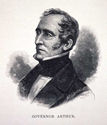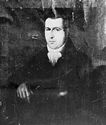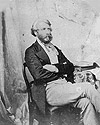

Picture album

Colonel David Collins arrived with the First Fleet in 1788 and, under the Governor, was responsible for the administration of legal matters in New South Wales until he returned to England in 1797. This portrait is from that time, when he was aged 42. In 1804 he chose the site of Hobart as the base for the new settlement he had been sent out to establish, and served as Lieutenant-Governor of Van Diemen's Land until he died in 1810.
Location: Archives Office of Tasmania [30/4053]
Related documents

George Arthur was appointed Lieutenant-Governor of Van Diemen's Land in 1823 and took office on 14 May 1824. For the next 12 years he was responsible for the Colony, separated from New South Wales the following year. This was longer than most Governors served, but in 1836, Arthur's autocratic and authoritarian rule led to his recall. By this time he was one of the wealthiest men in the Colony. This portrait of Governor Arthur is from a wood engraving by William Macleod for the second volume of the Picturesque Atlas of Australasia.
Location: The Allport Library [State Library of Tasmania]
Related documents

John Lewes Pedder was the first Chief Justice of Van Diemen's Land, serving for 30 years until his resignation in 1854. This portrait shows him aged 32 in 1824, the year he arrived in the Colony to take up his appointment. Pedder was also a Member of Tasmania's first Legislative Council, serving from 1825 until 1851, and a member of the Executive Council until 1836.
Location: Archives Office of Tasmania [30/280]
Related documents

This graphic statement of the operation of British law was issued by Governor Arthur in 1830, displayed on painted boards nailed to trees. In his first six years in charge of the Colony Arthur had become one of its largest landowners; he had also become convinced that British law could not achieve the intended 'conciliation'. In November that year he directed the military operation that (unsuccessfully) attempted to force all Aboriginal people from the settled parts of the Colony into the isolated Tasman Peninsula, where he had established Port Arthur prison in September. The incorrect title and date shown on this print suggest its source as an 1866 souvenir version of the original notices.
Location: The Allport Library [State Library of Tasmania]
Related documents

This 1840 painting idealised the work of George Augustus Robinson, who took up the post of 'Protector of Aborigines' in Van Diemen's Land on 27 January 1830. Benjamin Duterrau's The Conciliation was considered the first historical epic painting in the Australian colonies; it now marks the long path towards legal acknowledgment of Tasmanians of Indigenous descent.
Location: Tasmanian Museum and Art Gallery
Related documents

The Supreme Court and Police Office buildings in Murray Street, Hobart, sketched in 1838. Tasmania's Supreme Court, established on 10 May 1824, was the first in the Australian colonies.
Location: Archives Office of Tasmania [30/631]
Related documents

Fifty years before the design for the Australian flag was chosen, and a century before its legislative adoption, this flag, with the Union Jack and Southern Cross, was among the symbols used by the Australasian League established in Van Diemen's Land in 1851. The League's vigorous protests at British convicts being sent to the Colony, which had been separated from New South Wales in 1825, succeeded when transportation there ended in 1853. The name of the Colony was changed to Tasmania on 1 January 1856.
Location: Queen Victoria Museum and Art Gallery
Related documents

William Thomas Napier Champ was elected a Member for Launceston in Tasmania's new House of Assembly and on 1 November 1856 became the first Tasmanian Premier under responsible government. After his Ministry fell four months later, Champ moved to Victoria where he had been appointed Inspector-General of Prisons and where he was responsible for building Pentridge Gaol.
Location: Archives Office of Tasmania [NS407/15]
Related documents

Andrew Inglis Clark was a Member of the Tasmanian Parliament for various terms from his first election success in 1878; in 1898 he was appointed a judge of the Supreme Court of Tasmania. A prominent federalist, Clark was a chief author of Australia's Constitution, providing a draft constitution to the 1891 National Australasian Convention in Sydney and assisting Samuel Griffith, Edmund Barton and Charles Cameron Kingston in the revisions.
Location: The Allport Library [State Library of Tasmania]
Related documents

These decorations on Tasmania's Parliament House were for the Federation celebrations on 1 January 1901 – but the new State's parliamentarians might also have been celebrating having the building to themselves. The Legislative Council, established in 1825, and the House of Assembly, which first sat on 2 December 1856, shared the building with the Colony's Customs officers until 1903, when the final transfer of colonial Customs functions to the new Commonwealth was completed. Originally situated right on Hobart's Sullivan's Cove, this beautiful building was extended in 1940 to provide a new Chamber for the House of Assembly. The original section has served the Parliament for over 170 years, while the waterfront has gradually moved away from its front door, which now opens onto the gardens at Salamanca Place.
Location: Archives Office of Tasmania [30/2513]
Related documents

When the quickest way to find out election results was to wait outside newspaper offices where the results were posted on scoreboards, crowds gathered to watch electoral landslides in scenes like this one in Hobart on election night, 2 April 1903. This was the first post-Federation election for the reduced State Parliament, and the first Tasmanian election without the proportional representation (Hare-Clark) system since Andrew Inglis Clark had introduced it for the Hobart and Launceston seats in 1896. In 1907 Tasmania re-introduced the Hare-Clark system, which is also used in the Australian Senate. This photograph was published in the Tasmanian Mail on 11 April 1903.
Location: Archives Office of Tasmania